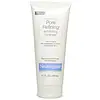What's inside
What's inside
 Key Ingredients
Key Ingredients

 Benefits
Benefits

 Concerns
Concerns

 Ingredients Side-by-side
Ingredients Side-by-side

Water
Skin ConditioningDecyl Glucoside
CleansingCetyl Alcohol
EmollientGlycol Distearate
EmollientSodium Laureth-13 Carboxylate
CleansingCocamide Mea
EmulsifyingDisodium Lauryl Sulfosuccinate
CleansingPolyethylene
AbrasiveCocamidopropyl Betaine
CleansingSodium Methyl Cocoyl Taurate
CleansingSalicylic Acid
MaskingGlycolic Acid
BufferingPolyquaternium-11
Linoleamidopropyl Pg-Dimonium Chloride Phosphate
Sodium PCA
HumectantPEG-150 Pentaerythrityl Tetrastearate
EmulsifyingHydroxypropyl Guar
Emulsion StabilisingDisodium EDTA
BHT
AntioxidantParfum
MaskingWater, Decyl Glucoside, Cetyl Alcohol, Glycol Distearate, Sodium Laureth-13 Carboxylate, Cocamide Mea, Disodium Lauryl Sulfosuccinate, Polyethylene, Cocamidopropyl Betaine, Sodium Methyl Cocoyl Taurate, Salicylic Acid, Glycolic Acid, Polyquaternium-11, Linoleamidopropyl Pg-Dimonium Chloride Phosphate, Sodium PCA, PEG-150 Pentaerythrityl Tetrastearate, Hydroxypropyl Guar, Disodium EDTA, BHT, Parfum
Water
Skin ConditioningSodium C14-16 Olefin Sulfonate
CleansingCocamidopropyl Hydroxysultaine
CleansingGlycerin
HumectantSodium Hydrolyzed Potato Starch Dodecenylsuccinate
Acrylates Crosspolymer-4
Emulsion StabilisingCellulose
AbsorbentPolysorbate 20
EmulsifyingCitric Acid
BufferingSodium Benzoate
MaskingGlycolic Acid
BufferingParfum
MaskingLactic Acid
BufferingSodium Hydroxide
BufferingDisodium EDTA
Carica Papaya Fruit Extract
Skin ConditioningHydrolyzed Hyaluronic Acid
HumectantWater, Sodium C14-16 Olefin Sulfonate, Cocamidopropyl Hydroxysultaine, Glycerin, Sodium Hydrolyzed Potato Starch Dodecenylsuccinate, Acrylates Crosspolymer-4, Cellulose, Polysorbate 20, Citric Acid, Sodium Benzoate, Glycolic Acid, Parfum, Lactic Acid, Sodium Hydroxide, Disodium EDTA, Carica Papaya Fruit Extract, Hydrolyzed Hyaluronic Acid
 Reviews
Reviews

Ingredients Explained
These ingredients are found in both products.
Ingredients higher up in an ingredient list are typically present in a larger amount.
Disodium EDTA plays a role in making products more stable by aiding other preservatives.
It is a chelating agent, meaning it neutralizes metal ions that may be found in a product.
Disodium EDTA is a salt of edetic acid and is found to be safe in cosmetic ingredients.
Learn more about Disodium EDTAGlycolic Acid is arguably the most famous alpha hydroxy acid (AHA) with tons of research backing its benefits.
It is found naturally in sugar cane but the form used in skincare is usually synthetic for purity and stability.
Glycolic acid removes the top layer of dead skin cells to allow newer and fresher ones to emerge.
AHAs work by breaking down the structural “glue” that holds old skin cells in place. When that buildup is gone, your skin can renew itself more efficiently.
Research also shows glycolic acid stimulates collagen production, helping to firm and thicken the skin over time. This is one of its biggest advantages over other AHAs.
Overall, glycolic acid helps with:
Fun fact: Glycolic acid boosts skin hydration by helping it produce molecules that increase hyaluronic acid naturally.
To work best, glycolic acid products should have a pH between 3-4 (that’s where exfoliation is most effective but still gentle on skin).
The pH and concentration of a product are key to its effectiveness:
It is normal to feel a slight stinging sensation when using glycolic acid. This usually fades as your skin adjusts.
Because glycolic acid has the smallest molecular size in the AHA family, it can penetrate deeper, which enhances its effectiveness but also makes it more likely to irritate sensitive skin.
If your skin is very sensitive or prone to rosacea, glycolic acid may be too strong; in that case, try milder options like lactic acid or a PHA instead.
Recent studies suggest glycolic acid might even help protect against UV damage. But don’t skip sunscreen! Freshly exfoliated skin is more sensitive to the sun.
Glycolic acid is a skincare superstar. It smooths, brightens, hydrates, and firms the skin. Unless you’re highly sensitive, it’s well worth adding to your routine.
Read more about some other popular AHA's here:
Learn more about Glycolic AcidParfum is a catch-all term for an ingredient or more that is used to give a scent to products.
Also called "fragrance", this ingredient can be a blend of hundreds of chemicals or plant oils. This means every product with "fragrance" or "parfum" in the ingredients list is a different mixture.
For instance, Habanolide is a proprietary trade name for a specific aroma chemical. When used as a fragrance ingredient in cosmetics, most aroma chemicals fall under the broad labeling category of “FRAGRANCE” or “PARFUM” according to EU and US regulations.
The term 'parfum' or 'fragrance' is not regulated in many countries. In many cases, it is up to the brand to define this term.
For instance, many brands choose to label themselves as "fragrance-free" because they are not using synthetic fragrances. However, their products may still contain ingredients such as essential oils that are considered a fragrance by INCI standards.
One example is Calendula flower extract. Calendula is an essential oil that still imparts a scent or 'fragrance'.
Depending on the blend, the ingredients in the mixture can cause allergies and sensitivities on the skin. Some ingredients that are known EU allergens include linalool and citronellol.
Parfum can also be used to mask or cover an unpleasant scent.
The bottom line is: not all fragrances/parfum/ingredients are created equally. If you are worried about fragrances, we recommend taking a closer look at an ingredient. And of course, we always recommend speaking with a professional.
Learn more about ParfumWater. It's the most common cosmetic ingredient of all. You'll usually see it at the top of ingredient lists, meaning that it makes up the largest part of the product.
So why is it so popular? Water most often acts as a solvent - this means that it helps dissolve other ingredients into the formulation.
You'll also recognize water as that liquid we all need to stay alive. If you see this, drink a glass of water. Stay hydrated!
Learn more about Water